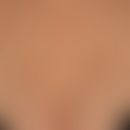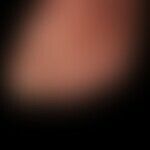Synonym(s)
DefinitionThis section has been translated automatically.
Fungal disease ( tinea) of the feet. Most common fungal disease with an incidence of 20% up to 80% (miners, soldiers) depending on the collective.
PathogenThis section has been translated automatically.
You might also be interested in
ClassificationThis section has been translated automatically.
Dyshidrotic type (vesicular form): Itchy, cloudy vesicles healing with scaly crusting, especially in the arch of the foot.
Interdigital type (dry or macerative form): Dry scaling or also macerated, grayish-white, swollen skin, erosions, rhagades in the interdigital spaces.
Moccasin type: Mostly dry scaling, white or slightly reddened, usually nonmarginal plaques on the sole of the foot in the form of a moccasin ( moccasin mycosis).
Squamous-hyperkeratotic type (hyperkeratotic-rhagadiform tinea): Mainly foot margins, toe tips, heel are affected. Well demarcated, focal, scaly hyperkeratosis, possibly with rhagades.
Oligosymptomatic type: Minimal redness of the interdigital spaces between the toes. Hyperkeratosis with finely lamellar scaling on heels and edges of feet. Frequently also tinea unguium.
Occurrence/EpidemiologyThis section has been translated automatically.
In Germany, an estimated 10 million people suffer from tinea pedis.
In larger Japanese dermatological patient collectives (n=36,000), tinea pedis was present at 8.2% (Sei Y 2015)
Weighting of risk factors in descending order:
- Familial disposition
- Foot deformities
- Use of public bathing facilities or use of public changing rooms.
- Occlusive effect due to wearing tight shoes (sports shoes).
- Male gender
- Trauma
- Peripheral neuropathy
- Diabetes Mellitus
- Circulatory disorders.
EtiopathogenesisThis section has been translated automatically.
ClinicThis section has been translated automatically.
Dyshidrotic type (vesicular form): Itchy, cloudy vesicles healing with scaly crusting, especially in the arch of the foot.
Interdigital type (dry or macerative form): Dry scaling or also macerated, grayish-white, swollen skin, erosions, rhagades in the interdigital spaces.
Moccasin type: usually dry scaling, white or slightly reddened, usually nonmarginal plaques on the sole of the foot in the form of a moccasin ( moccasin mycosis).
Squamous-hyperkeratotic type (hyperkeratotic-rhagadiform tinea): Mainly foot edges, toe tips, heel are affected. Well demarcated, focal, scaly hyperkeratosis, possibly with rhagades.
Oligosymptomatic type: Minimal redness of the interdigital spaces between the toes. Hyperkeratosis with finely lamellar scaling on heels and edges of feet. Frequently also tinea unguium.
DiagnosisThis section has been translated automatically.
Native and cultural fungal detection (procedure: see mycology examination methods).
In addition, there is the possibility of diagnostics using the (multiplex) polymerase chain reaction (PCR - e.g. EURO-Array Dermatomycosis - Euroimmun, Groß Gronau). This method impresses with its high sensitivity and speed in diagnostics (Bieber K et. a. 2021). The method can detect >50 fungi.
Differential diagnosisThis section has been translated automatically.
Complication(s)(associated diseasesThis section has been translated automatically.
TherapyThis section has been translated automatically.
Antimycotics external, see below. Tinea. Dry blow-drying of the spaces between the toes. Elimination of terrain factors (wearing of bathing shoes in swimming pools and sauna and wellness areas), disinfection of stockings and shoes (e.g. Cutasept spray), daily change of stockings. Washing of stockings and towels at 60 °C or with the addition of disinfectants (Sagrotan laundry solution, Impressan laundry solution). Allow shoes to dry for at least one day. Cleaning of carpets, floor coverings (especially in bathrooms), etc.
Progression/forecastThis section has been translated automatically.
ProphylaxisThis section has been translated automatically.
Wearing bathing shoes in public common areas such as locker rooms, showers and saunas. Use of disinfecting foot sprays in swimming pools.
Prophylactic use of antifungal solutions/sprays (e.g. Canesten spray) 2-3 times/week in interdigital spaces and on the soles of the feet.
Disinfection of contaminated objects (e.g. disinfection of shoes with Sagrotan spray).
Rubbing feet clean with a towel or washing feet with soap can reduce the number of fungi on the soles of feet. Avoiding walking barefoot on the carpeting of hotel rooms.
NaturopathyThis section has been translated automatically.
Lavender oil can be used as an alternative to the disinfectants: 10 drops/l. The disinfectant effect is 22 times stronger than that of the disinfectants mentioned above.
Vinegar applications are also mentioned in naturopathy. Dab undiluted apple cider vinegar on affected areas several times a day and before going to bed. Daily apple cider vinegar baths are also recommended.
A naturopathic alternative are 25% or 50% tea tree preparations, Melaleuca alternifolia, or 1% eucalyptus oil. Both preparations are probably based on the antimicrobial effect of cineole.
Diet/life habitsThis section has been translated automatically.
AftercareThis section has been translated automatically.
Note(s)This section has been translated automatically.
LiteratureThis section has been translated automatically.
- Bieber K et al (2021) DNA-chip based diagnosis of onychomycosis and Tineda pedis. JDDG 20:1112-1122
- Satchell AC et al. (2002) Treatment of interdigital tinea pedis with 25% and 50% tea tree oil solution: a randomized, placebo controlled blinded study. Australas J Dermatol 43: 175-178
- Seebacher C et al (2007) Onychomycosis. J Dtsch Dermatol Ges 5: 61-66
- Seebacher C et al (2005) Tinea of the free skin. J Dtsch Dermatol Ges 11: 921-926
- Sei Y (2015) 2011 Epidemiological Survey of Dermatomycoses in Japan. Med Mycol J 56:J129-135
- Shahi SK et al. (2000) Broad spectrum herbal therapy against superficial superficial fungal infections. Skin Pharmacol Appl Skin Physiol 13: 60-64
Incoming links (32)
Amorolfin; Athlete's foot; Athlete's foot; Athlete's foot disease; Atopic juvenile plantar dermatosis; Cineol; Dermatomycoses; Epidermophytia pedis; Epidermophyton floccosum; Eucalypti aetheroleum; ... Show allOutgoing links (22)
Acrocyanosis; Antimycotics; Candidoses; Contact allergy (overview); Dyshidrosis; Erysipelas; Eucalyptus; Hand and foot eczema, hyperkeratotic-rhagadiformes; Hyperhidrosis (overview); Intertrigo; ... Show allDisclaimer
Please ask your physician for a reliable diagnosis. This website is only meant as a reference.
























